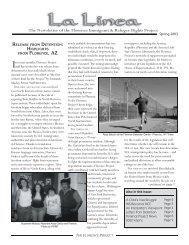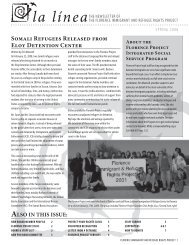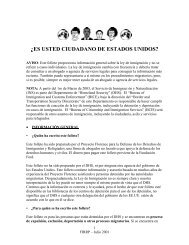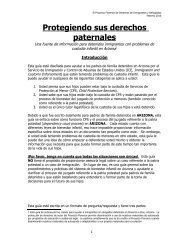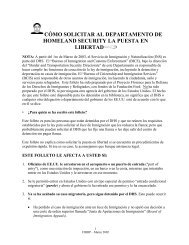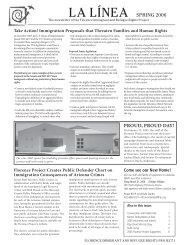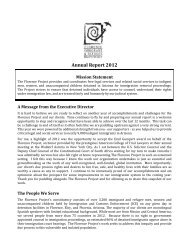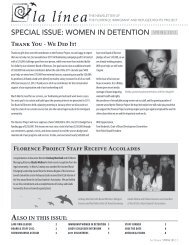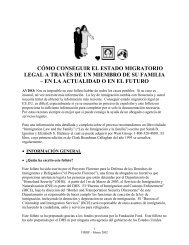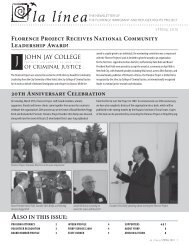quick reference chart and annotations for determining immigration ...
quick reference chart and annotations for determining immigration ...
quick reference chart and annotations for determining immigration ...
Create successful ePaper yourself
Turn your PDF publications into a flip-book with our unique Google optimized e-Paper software.
Immigrant Legal Resource Center, Florence Immigrant <strong>and</strong> Refugee Rights Project,<br />
Maricopa County Public Defender August 2012<br />
Aggravated Felony: No. This does not equal burglary or a crime of violence. However, as with<br />
all offenses, <strong>for</strong> further protection counsel should attempt to obtain a sentence of 364 days or less, which<br />
ought to be possible <strong>for</strong> this class 6 felony.<br />
32. Burglary Offenses<br />
Burglary in the Third Degree, ARS §13-1506<br />
A. A person commits burglary in the third degree by:<br />
1. Entering or remaining unlawfully in or on a nonresidential structure or in a fenced commercial or<br />
residential yard with the intent to commit any theft or any felony therein.<br />
2. Making entry into any part of a motor vehicle by means of a manipulation key or master key, with the<br />
intent to commit any theft or felony in the motor vehicle.<br />
B. Burglary in the third degree is a class 4 felony.<br />
Summary: Obtaining a sentence imposed of 364 days or less will avoid aggravated felony<br />
classification. If a sentence of a year or more is imposed, however, counsel still can guard against AF<br />
classification. In sum, if a sentence of a year or more will be imposed, to avoid both a CMT <strong>and</strong><br />
aggravated felony conviction the client should plead to A1 with record of conviction stating<br />
“nonresidential structure or in a fenced commercial or residential yard” or any wording that includes “a<br />
fenced commercial yard,” <strong>and</strong> “theft or any felony” or “a felony;” or plead to A2 with a record of<br />
conviction stating “theft or any felony” or “a felony.” If possible, it is better to leave the record vague<br />
between conviction under A1 or A2. Burglary is potentially a CMT, but careful creation of the record of<br />
conviction may avoid this as well.<br />
Crime Involving Moral Turpitude: This is a divisible statute. The key is to avoid a record or<br />
any evidence demonstrating that the client pleaded to an offense with an intent to commit a CMT after<br />
entry.<br />
A1, A2. Unlawful entry or remaining unlawfully are not themselves CMTs. Cuevas-Gaspar v.<br />
Gonzales, 430 F.3d 1013 (9th Cir. 2005); Matter of G, 1 I. & N. Dec. 403 (BIA 1943); Matter of M, 9 I.<br />
& N. Dec. 132 (BIA 1960). Burglary becomes a CMT only if the intended offense involves moral<br />
turpitude. Entry with intent to commit larceny is a CMT, while entry with intent to commit an<br />
undesignated offense (“a felony”) or an offense that does not involve moral turpitude is not. Matter of M,<br />
2 I&N Dec. 721 (BIA 1946). Defense counsel should create a record of conviction where the client is<br />
guilty only of “theft or any felony” or “a felony.” (To determine whether an offense may be found<br />
turpitudinous in <strong>immigration</strong> court, see Matter of Silva-Trevino, 24 I&N Dec. 687 (A.G. 2008).)<br />
Because Arizona theft statutes include subsections that do not require intent to permanently deprive the<br />
owner of benefits, <strong>and</strong> since traditionally an intent to permanently deprive is required <strong>for</strong> moral turpitude,<br />
even a plea to intent to commit an undesignated theft may avoid CMT. The disadvantage of “any theft” is<br />
that <strong>immigration</strong> judges are trained to think that any theft is a CMT, while they recognize that “any<br />
felony” may not be.<br />
The Ninth Circuit has also held that attempted commercial burglary in which the defendant<br />
entered a store with the intent to shoplift is not a CMT. Hern<strong>and</strong>ez-Cruz v. Holder, 651 F.3d 1094, 1109<br />
(9th Cir. 2011). Counsel can avoid a CMT by creating a factual basis that the defendant merely entered<br />
the store lawfully with intent to commit a theft. This is a good alternative to theft or shoplifting since<br />
even police reports or other documents showing that defendant actually committed theft should not<br />
Arizona Criminal Chart with Explanatory Endnote – August 2012<br />
45



